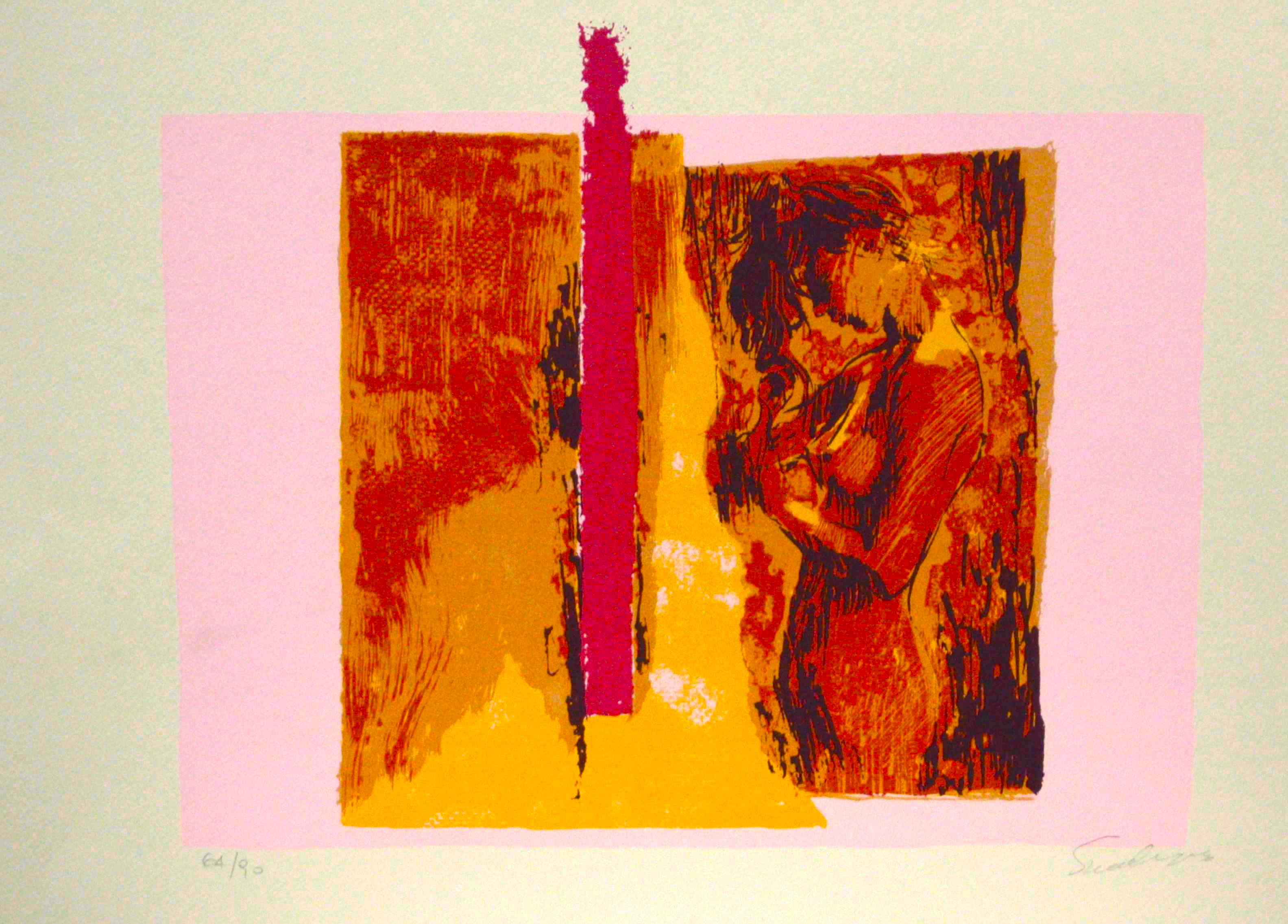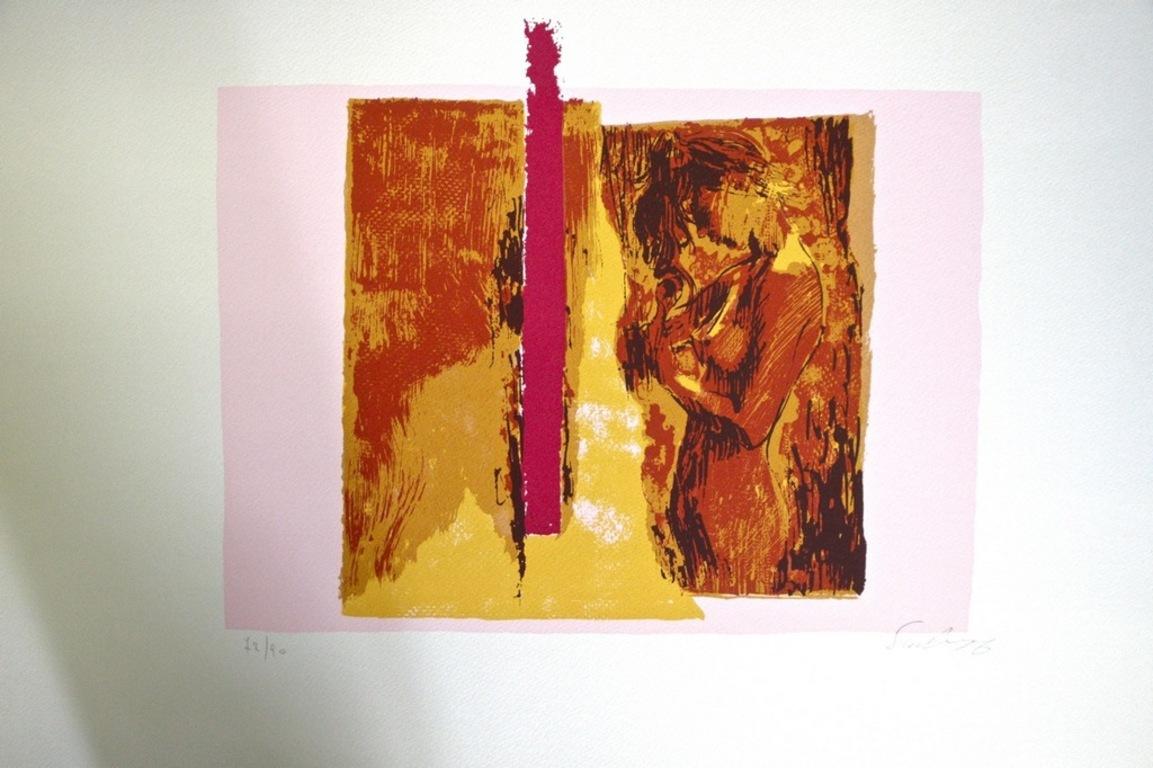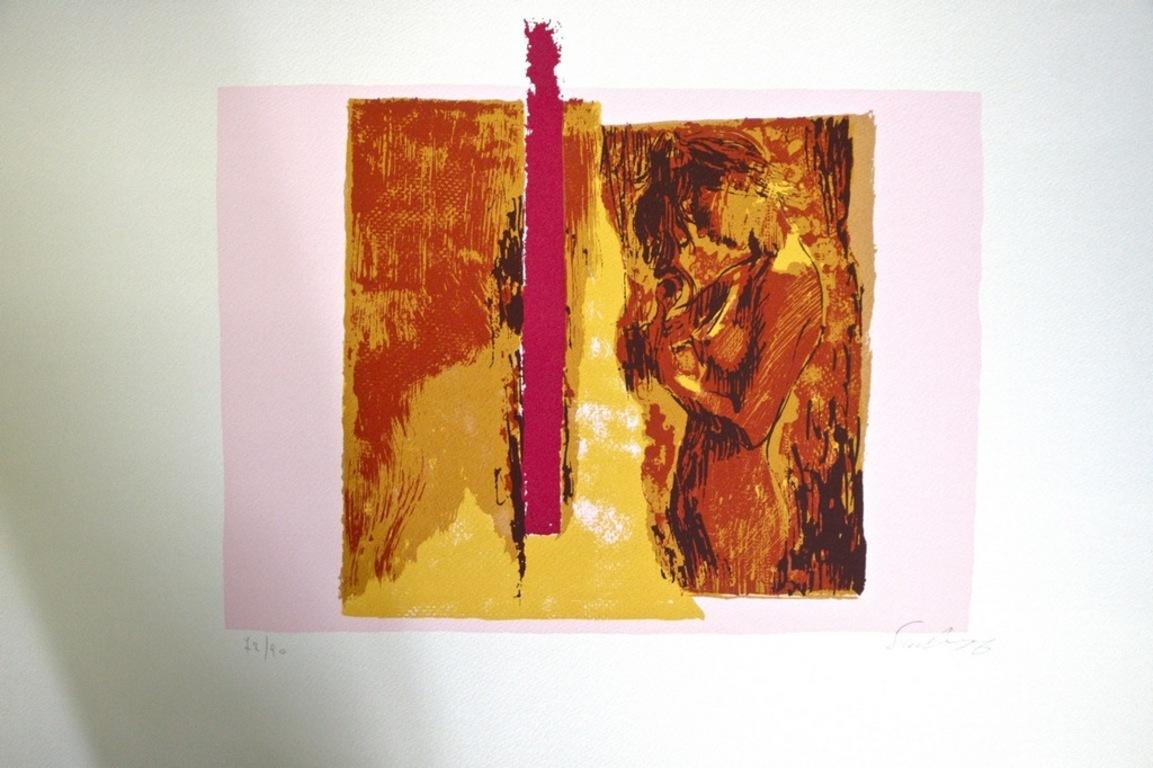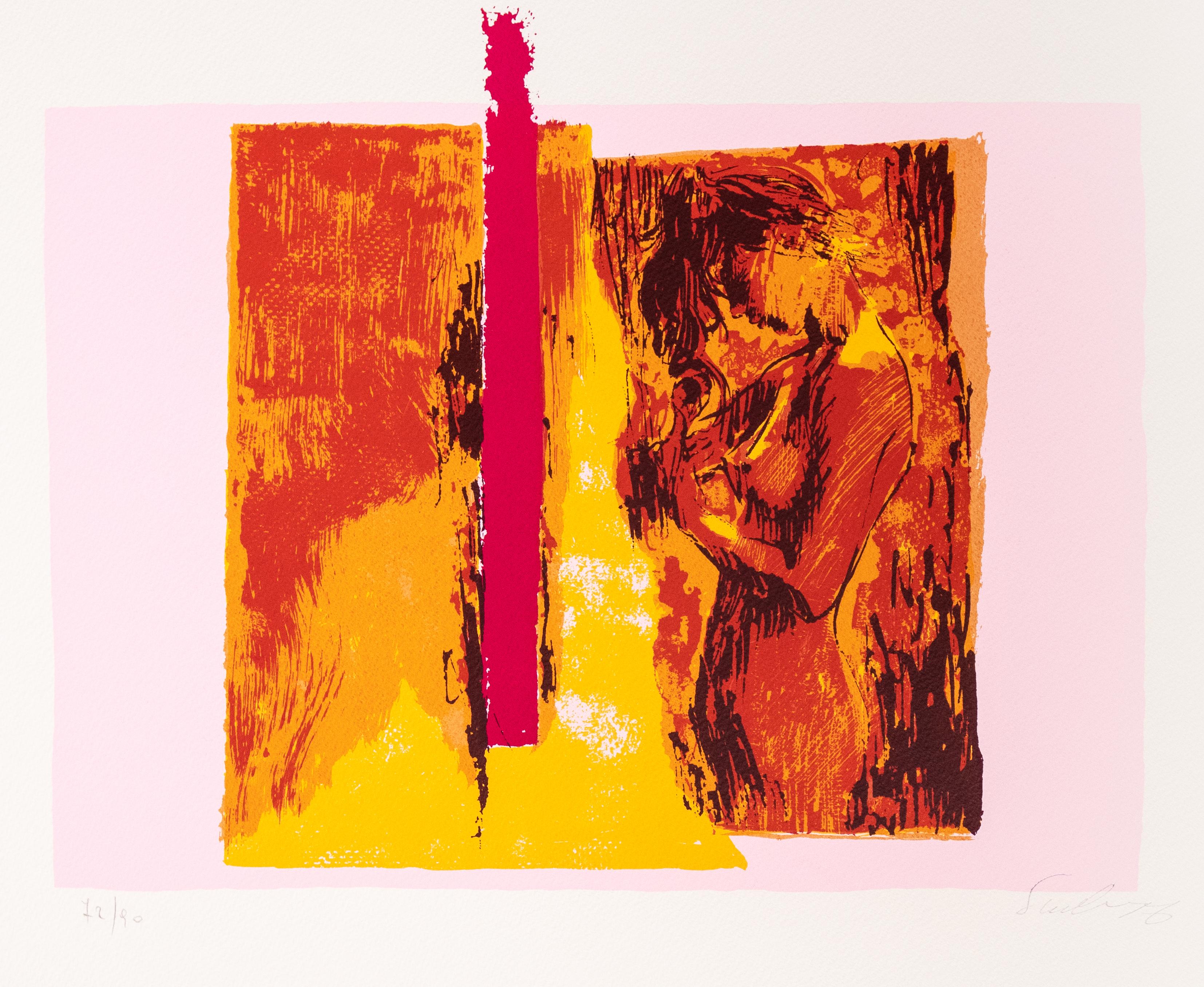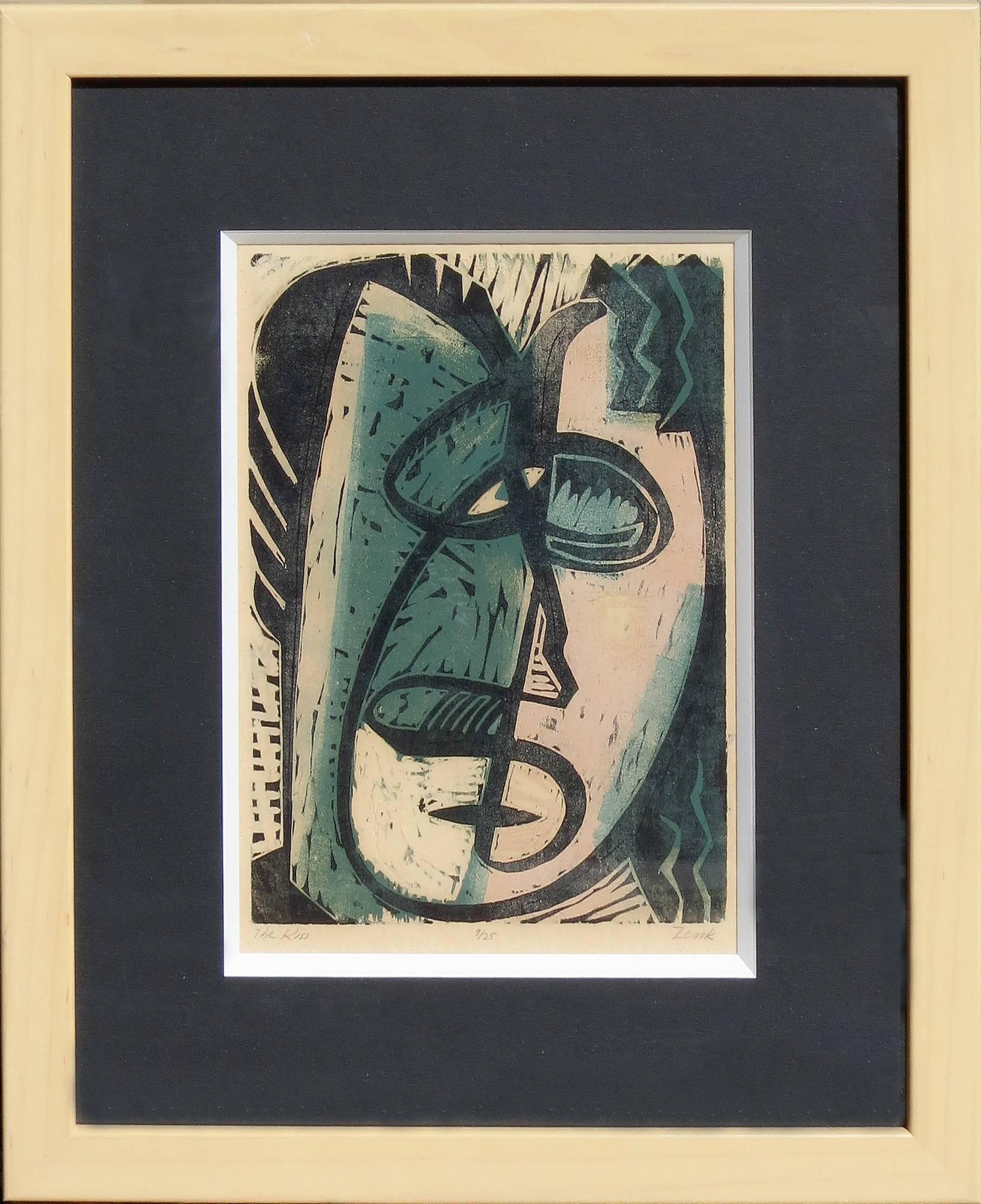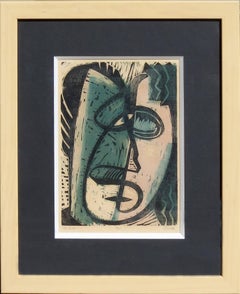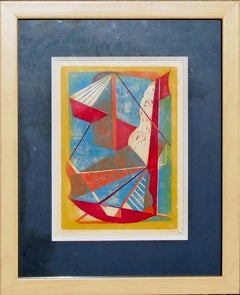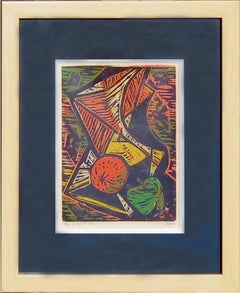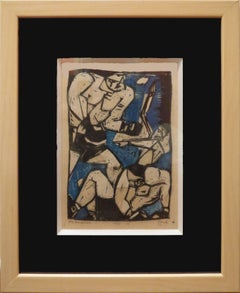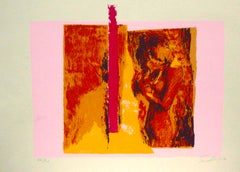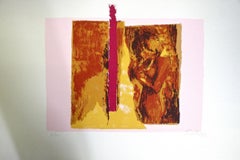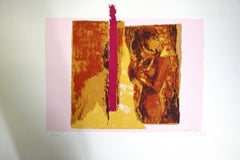Items Similar to "Pink Lady"
Want more images or videos?
Request additional images or videos from the seller
1 of 8
Josef Zenk"Pink Lady"
$7,000
£5,451.13
€6,200.65
CA$10,081.17
A$11,062.82
CHF 5,778.17
MX$132,268.34
NOK 73,190.71
SEK 68,264.11
DKK 46,310.15
About the Item
Signed Lower Right
Titled and Numbered Lower Left
Josef Zenk (1904-2000)
Josef Zenk was born in New York City in 1904. After graduating from high school he studied for three years at the National Academy of Design, followed by further studies at the Art Students League in New York.
In 1926, Zenk moved to Utica, New York, where he began to produce landscape, figurative, and still life paintings. He was part of a small community of artists who in 1927-28 organized exhibitions with many of the leading American painters including Hopper, Sheeler and Fiene. In 1930 he was granted a full scholarship to study at the Munson Williams Proctor Institute where he later became an Instructor until World War II. While there, an exhibition of his work produced the greatest attendance of any show at the institution of that year. In 1942 "Zuni" by Zenk became the first work purchased by the Munson Williams Proctor Institute for its Central New York Artists Collection.
After service in the Armed Forces from 1942-1945, Zenk left Utica and moved his studio to Palisades Park, New Jersey. Under the G.I. Bill he began to study at the New School in New York City. Along with Louis Schanker, a prominent woodcut artist and teacher at the New School, Zenk and a small group of printmakers formed Studio 74 for the purpose of exhibiting their color wood block prints. The group received immediate critical attention. The New York Times described the work of Josef Zenk as "particularly admirable". One of his prints "The Kiss" was chosen in 1949 as one of the best prints of the year and was exhibited in the National Exhibition of Prints held at the Library of Congress in Washington D.C.
Zenk moved to Bucks County, Pennsylvania in the late 1940's and lived in Upper Black Eddy, a town along the Delaware River, ten miles north of New Hope. He maintained a studio in Palisades Park for while after the move, before eventually working fulltime from his studio in Pennsylvania. Zenk remained active painting and making woodblock prints, while also teaching art classes. He resided in Bucks County until the end of his life at the age of ninety six.
Like several other important Pennsylvania and New Jersey artists, the work of Josef Zenk was only recently rediscovered and brought to light. For the remaining thirty five years of his life, he chose a somewhat reclusive lifestyle, away from the frenetic art scene.
Josef Zenk's works have been shown in over twenty seven museums including the San Francisco Museum of Art, the Brooklyn Museum, the Newark Museum, the Seattle Museum of Art, and the National Academy of Design. Through the many exhibitions during his career, he has progressed from a stylized realism in landscape and figure painting to a powerful modernist and abstract style with a strong sense of personal expression.
Sources: New Hope for American Art by James M. Alterman
- Creator:
- Dimensions:Height: 22 in (55.88 cm)Width: 19 in (48.26 cm)Depth: 2 in (5.08 cm)
- Medium:
- Movement & Style:
- Period:
- Condition:
- Gallery Location:Lambertville, NJ
- Reference Number:Seller: PB02222017691stDibs: LU1571629503
About the Seller
5.0
Vetted Professional Seller
Every seller passes strict standards for authenticity and reliability
1stDibs seller since 2013
13 sales on 1stDibs
- ShippingRetrieving quote...Shipping from: Lambertville, NJ
- Return Policy
More From This Seller
View All"The Kiss"
By Josef Zenk
Located in Lambertville, NJ
Signed Lower Right
Titled Lower Left
Josef Zenk (1904-2000)
Josef Zenk was born in New York City in 1904. After graduating from high school he studied for three years at the Natio...
Category
20th Century Abstract Figurative Prints
Materials
Paper, Color
$7,000
"Swinging"
By Josef Zenk
Located in Lambertville, NJ
Signed Lower Right
Josef Zenk (1904 - 2000)
Josef Zenk was born in New York City in 1904. After graduating from high school, he studied for three years at the National Academy of D...
Category
20th Century Abstract Abstract Prints
Materials
Color, Woodcut
$4,600
"Bag of Fruit"
By Josef Zenk
Located in Lambertville, NJ
Signed Lower Right
Edition # 9/18
Josef Zenk (1904 - 2000)
Josef Zenk was born in New York City in 1904. After graduating from high school, he studied for three years at the Natio...
Category
20th Century Abstract Abstract Prints
Materials
Color, Woodcut
$4,100
"The Knockdown"
By Josef Zenk
Located in Lambertville, NJ
Signed Lower Right
Titled Lower Left
Numbered Lower Center
Josef Zenk (1904-2000)
Josef Zenk was born in New York City in 1904. After graduating from high school he studied ...
Category
1940s Abstract Figurative Prints
Materials
Color, Woodcut
"Classic Maiden"
By Vaclav Vytlacil
Located in Lambertville, NJ
Signed & Dated LR
Vaclav Vytlacil (Vas-lav Vit-la-chil) was born in New York City in 1892 to Czech parents, but was raised in Chicago. He was an artist since boyhood, becoming the y...
Category
20th Century Abstract Portrait Paintings
Materials
Canvas, Oil
"Toccata"
By Hilla Rebay von Ehrenwiesen
Located in Lambertville, NJ
Cut Paper Collage, Signed LR
Hilla Rebay was an avant-garde artist who believed deeply in the power of intuition while creating art. She was the progenitor of The Museum of Non-Obj...
Category
20th Century Abstract Expressionist Mixed Media
Materials
Paper
You May Also Like
Pink Lady
Located in San Francisco, CA
THis artwork "Pink Lady" 1989, is an acrylograph on hand made paper by noted Mexican artist Byron Galves, 1941-2009. It is hand signed, dated and numbered 64/150 in white pencil by the artist.The artwork size is 28.5 x 15.5 inches, paper sheet size is 32 x 23.85 inches, framed size is 44 x 36 inches. Beautifully custom framed in a wooden silver frame, with dark purple backing and bevel. It is in excellent condition, the frame have some small minor restorations, barely visible.
About the artist:
Byron Gálvez (October 28, 1941 – October 27, 2009) was a Mexican artist who was primarily known for his painting but also created sculpture, including monumental works. He was born in rural Hidalgo state, to a father who played jazz music and read literature, a rarity in 1930s rural Mexico. However, it exposed Gálvez to culture, even though this led to an interest in visual art rather than musing or writing.
He went to Mexico City to study art at both the undergraduate and graduate level, but never completed his degrees, opting instead to begin career after his coursework. Before his first individual exhibition, his work was criticized by Justino Fernández, but all of the paintings were sold in advance to foreign buyers including American actor Vincent Price, who called Gálvez a “Mexican Picasso.” Gálvez then managed to replace the forty five paintings for the exhibition in a week. Since then he had individual and collective exhibitions in Mexico, the United States and other parts of the world. He concentrated on painting, which he is better known for, in the 1970s and 1980s, but moved on to sculpture, including monumental works later in his career. Recognitions for Gálvez's work include membership in the Salón de la Plástica Mexicana, a retrospective at the Palacio de Bellas Artes and two books published about his life.
Gálvez was born in Mixquiahuala, Hidalgo and described his childhood as happy, and would not have changed it. His father, Roberto Gálvez, was a farmer and merchant, who was a music and literature enthusiast, a rarity is 1930s rural Mexico. His father played the violin in the town's jazz band, which had almost all classical instruments, making it similar to bands in New Orleans. They even composed new pieces. The artist was named after Lord Byron, and his brothers, Eliot, Aníbal and Dante, after his father's reading preferences
This meant that Gálvez grew up in an environment that encouraged the enjoyment of the arts. However, instead of music or literature, Gálvez stated that his earliest memories related to his attraction to art and that he always wanted to be a painter. The difficulties of farm life convinced him that he needed an education and would have to move to Mexico City in order to go to school. At age sixteen he left home for the capital to study painting at the Escuela Nacional de Artes Plásticas, not knowing what the study would entail. It was far more rigorous than he expected, with thirteen-hour school days leaving only weekends to earn money to live on.[3] He did his undergraduate studies from 1958 to 1962, then continued with the graduate courses from 1962 to 1964, specializing in painting.
He did much of his studies under teachers such as Luis Nishizawa, Fernando Castro Pacheco, Francisco Moreno Capdevila, Santos Balmori, Antonio Rodríguez Luna and Antonio Ramírez. The last teacher taught him to love his studies above all else and he submitted himself to the academic rigor. This led him to become attracted to the Cubism of Picasso, and felt that the artist has opened roads which could be taken and widened. Although he specialized in painting, his interest in sculpture was also evident at this time as he was a founding member of a metal sculpture workshop at the institution along with Armando Ortega and Baltazar Martinez.[2][5] Although he completed his coursework, he did not finish the other requirements needed for the degree, instead opting to start his career.
Gálvez married once to art dealer Eva Beloglovsky.The couple first met in 1973, but did not meet again until two years later, when Beloglovsky bought one of his paintings and sold two more through her art gallery. At first it was a working relationship, and then evolved into a romantic one. During their marriage, they worked on a number of projects together such as multi-media presentations and charity benefits. The couple remained together until Galvez's death.
Although he began and developed much of his career in Mexico City, in his later life, the artist moved back to his rural hometown. Gálvez constructed a house and studio on the edge of a ravine in which flows the Moctezuma River. The structure has glass walls positioned for maximum light and a privileged view of a local landmark, a hill called El Elefante.
Gálvez's work included painting, sculpture, etching, lithography, and drawing.[4] For Galvez, art was spiritual and disconnected with physical logic, when only aesthetics mattered. Female figures are common, and often are sensual. He work has been influenced by the Cubism of Picasso and Georges Braque, by African and Oceanic folk art and by pre-Columbian sculpture. He preferred large scale works often bigger than seven by seven feet. He painted while listening to classical, jazz and occasionally, rock music.
Galvez's work experienced periods in which different artistic currents dominated including expressionism, abstract art and mixtures of the two. In his work, he tried to achieve a balance between figurative and abstract expression. The first stage of his painting was figurative expressionism, then abstract expressionism, under strong influence of Carlos Mérida, Rufino Tamaho, Santos Balmori, Kandinsky, Wifredo Lam and Picasso, along with some from classical painters such as Rembrandt and Caravaggio. Then for some time, he practiced abstract art, but then felt the need to draw human bodies again, especially female ones because he felt it allowed him better expression. Around 1980, he moved on to geometric figurativism, marked by the “Woman” exhibit at the Museum of Modern Art. This has also been describes as “pure chromatic constructivism. He considered himself primarily a sculptor and painted in that fashion. The work of Byron Galves is held in numerous corporate and private collections
Galvez died at age 67 at Inglés Observatorio Hospital from a heart attack. His ashes were deposited a year after his death to the side of one of the sculptures at his home in Mixquiahuala.
During his career, he exhibited individually and collectively in over sixty venues in Mexico, various cities in the United States, Europe and Latin America. In 1964, he had his first individual exhibition at the ENAP Gallery, after showing in collective exhibitions at the Palacio de Bellas Artes and private galleries along with more prominent painters such as José Chávez Morado, Alfredo Zalce, José Clemente Orozco, Diego Rivera, Carlos Orozco Romero and David Alfaro Siqueiros. Before the opening of this exhibit, his work was severely criticized by art historian Justino Fernández. Despite this, the paintings for the exhibit were bought in advance, most by American actor Vincent Price, who called Gálvez a “Mexican Picasso.” The paintings were taken out of the country one week before the exhibit, but Gálvez was not concerned about not having paintings for the show, rather he was satisfied about his work being recognized and supported.He managed to create forty five more paintings in the remaining time in order to have the exhibit. After this individual exhibit, Gálvez had over 55 more over he career, along with participated in other 75 collective exhibits. Important exhibits include the Solar 68 collective exhibition at the Palacio de Bellas Artes (1968), the Sterenberg Galleries, Chicago (1972), Eye Corporation in various US cities (1973), Polyforum Cultural Siqueiros (1978), Museo de Arte Moderno in Mexico City (1982), Harcourts Contemporary Gallery in San Francisco (1983, 1990), Art-Forum Gallery in Mexico City (1984), Bishop Gallery in Phoenix (1989), Merryl Chase Gallery in Washington, DC (1991, 1992), Suhan Galleries in San Diego (1992), Misrachi Gallery (1994) and San Francisco Theater in Pachuca (1995) .[4][2] After his death, the Secretaría de Relaciones Exteriores sponsored an exhibition of his work in Tainan, Taiwan in 2011. His works can be found in major collections in both Mexico and the United States. The strongest demand has been for his figurative work especially that produced later in his life. Gálvez also created murals and sculptures, both small and monumental. His first mural was sculpted done in 1968 in Los Angeles. However, most of his monumental work was produced later in his career as he concentrated on painting in the 1970s and 1980s. These include a mural at the National Conservatory of Music in Mexico City (1970), a thirty-foot high sculpture in Unidad Morelos in Mexico City (1971), a hand hammered copper triptych for a private residence in Mexico City (1984), a sculpted door for a private residence (1985), a sculpture for a private home in New York (1986), Reclined Torso at the Hotel Nikko Mexico (1998), Torso I a five-foot high sculpture for the city of Pachuca (1999), Torso II a nineteen foot high sculpture at the Altiva Building, Mexico City (1999), Millenium, a bronze sculpture/fountain at the highway entrance to Pachuca (2000), a sculpture garden for Mixquiahuala, Hidalgo (2005) and the master plan and central mosaic for the David Ben Gurion Cultural Park in Pachuca (2007). The park project, the last before his death, included not only the creation of the central mosaic, the largest pedestrian mural in the world at 345,000f, but also the design of the 65-acre park itself. His other activities included the teaching of drawing at his alma mater, the creation of a program for the radio ministry of Mexico in 1973, participation in a documentary about lithography in Mexico in 1980 and the creation of several special programs for the office Radio...
Category
Late 20th Century Modern Nude Prints
Materials
Other Medium
Woman in Pink - Original Lithograph by Nicola Simbari - 1976
By Nicola Simbari
Located in Roma, IT
Limited edition of 90 prints, numbered and hand signed.
Category
20th Century Figurative Prints
Materials
Lithograph
Woman in Pink - Screen Print by Nicola Simbari - 1976
By Nicola Simbari
Located in Roma, IT
Hand Signed. Edition of 90 pieces.
Category
1970s Contemporary Nude Prints
Materials
Screen
$267 Sale Price
40% Off
Woman in Pink - Screen Print by Nicola Simbari - 1976
By Nicola Simbari
Located in Roma, IT
Hand Signed and numbered. Edition of 90.
Very good condition.
Category
1970s Contemporary Nude Prints
Materials
Screen
Woman in Pink - Original Lithograph by Nicola Simbari - 1976
By Nicola Simbari
Located in Roma, IT
Limited edition of 90 prints, numbered and hand signed.
Excellent condition.
Category
1970s Contemporary Figurative Prints
Materials
Lithograph
Girl in Pink - Woodcut by Mino Maccari - Mid-20th Century
By Mino Maccari
Located in Roma, IT
"Girl in Pink" is an original woodcut artwork realized by Mino Maccari (1898-1989).
Hand-signed on the lower right in pencil, and numbered on the lower left, edition of 71/89 print...
Category
Mid-20th Century Modern Figurative Prints
Materials
Woodcut
More Ways To Browse
Signed Picasso 50
Sinatra Neiman
Source Perrier
Stik Signed
Surrealist Piano Salvador Dali
Takashi Murakami Enso
Tal R
Tarkay Signed Print
Thomas McKnight On Sale
Tokuriki Tomikichiro
Tracey Emin Heart
Vampire Vintage Art
Van Gogh Etching
Vegetable Dog
Vick Vibha
Vintage 1960s Fashion Illustration
Vintage Athena Prints
Vintage Braniff Posters
